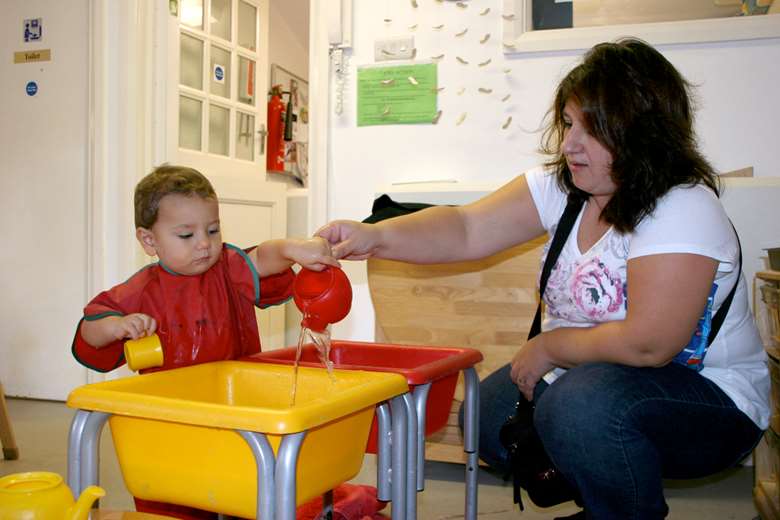Initiatives boost childcare take-up
James Hempsall
Monday, August 31, 2015
A year since the reach of free childcare was doubled for two-year-olds, local areas are ensuring families benefit.

The achievements to date in providing 15 hours of free childcare to disadvantaged two-year-olds gives us invaluable learning to inform future development of this and similar initiatives, such as the upcoming 30 hours for three- and four-year-olds whose families work.
Local authorities, early years providers and schools have already embraced the initiative. Since 2012, the A2YO team has been working to provide information sharing, support and challenge to make it happen.
Strategies to stimulate demand that work well in one area may not be as successful for another. Likewise, some strategies to develop places are not suited to all areas - they depend so much on the local market, range and type of providers, constraints and opportunities presented by premises, funding rates matched to the local economy, and competing agendas and demands for space.
The message given to eligible families must be clear and constantly communicated by all. It needs to be easy to navigate, without barriers and full of informed choices.
There must also be enthusiastic, effective leadership and management throughout the local authority, and in all the children's centres and providers delivering the entitlement.
We have had a three-pronged focus on: quality provision; developing places capacity in new and extended settings; and reaching and engaging eligible families.
Take-up rates - measured as the percentage of eligible children being funded - vary widely across the country, as plans develop at a different pace. We've moved from funding 20,000 in 2010, towards 160,000 now funded at any one time.
We have compiled a set of 10 common characteristics of areas where take-up is highest in a guide published this autumn, Achieving For All Two-Year-Olds - Learning From What Works. Not all areas will show all of these characteristics, and some with lower take-up have adopted many of the suggestions.
1 Local authority strategic management commitment and leadership
2 Implementation team access to finance and ability to make spending decisions
3 Everyone able to act swiftly and early to build momentum
4 Partnership with early years providers to change and deliver
5 Ensure the best quality of provision appropriate for least advantaged two-year-olds and their families
6 Marketing and promotion to reach families, raise awareness and achieve take-up
7 Effective and efficient journey for parents, from awareness to take-up
8 Management of the local childcare market through the local authority's Childcare Act (2006) duties
9 Partnership working to enable diverse and far-reaching outreach and engagement
10 Fit for purpose IT and online systems to support everyone, especially partners, providers and low-income working families
WIDENING ACCESS: THREE SUCCESS STORIES
Stockton-On-Tees Borough Council developed its "Journey to Outstanding" guidance to early years settings six years ago, now validated by National Children's Bureau.
It promotes welfare, safeguarding and good quality, with questions and prompts for providers such as the extent to which children adopt good hygiene practices; or whether they recognise the importance of physical activity and healthy diets.
It gives examples of creating good environments for children, guidance on managing resources, supporting children with additional needs, promoting learning through play and logging evidence.
Most settings across the borough use the guidance.
Early years manager Janet Marriott says it has helped boost the number of providers with "Good" and "Outstanding" Ofsted ratings, in turn increasing the number able to offer places for two-year-olds.
"The guidance was put together and made suitable for childminders, pre-schools, out-of-school clubs and nurseries," says Marriott. "It belongs to the settings. They take ownership of it."
She adds: "Everyone has helped to promote the guidance. We have good partnerships across the sector and our local authority sees value in what we're doing."
Cheshire East Council has developed guidance entitled Are you ready for me now I'm two?, used by early years settings and other authorities.
It covers advice on the unique child; positive relationships; enabling environments; and learning and development with a section to be added on integrated reviews, which came into force this month and combine education and health reviews of child development.
Early years and childcare manager Carol Sharples describes the guidance as a "best practice toolkit". She says improved take-up and quality are mutually exclusive: "Improving take-up needs quality providers. We wanted to increase places but that meant improving quality."
Trafford Metropolitan Borough Council runs its own initiatives and works with the nine other authorities in the Greater Manchester area to boost take-up and quality.
As part of the Association of Greater Manchester Authorities (AGMA), Trafford works to share best practice and common principles.
Alison Milne, head of service for access and inclusion, says this often means sharing funding: "We agreed as a group about cross-border funding, that we'd fund families regardless of where they live. It makes it easier for families to access places across the area."
The authorities issue joint marketing messages and share good ideas. "It's all about working collaboratively. We talk with the other AGMA authorities about making better use of resources," Milne adds.
One of the council's own initiatives, to hold taster sessions in early years settings for parents in deprived areas, has been replicated by the other councils.
- By Jess Brown




